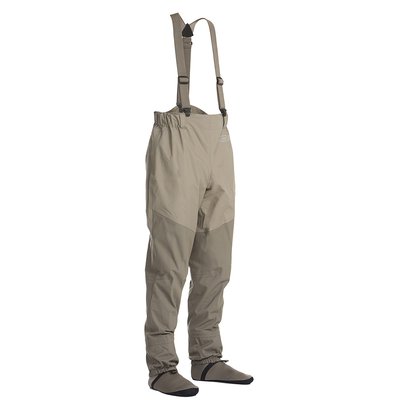Wader Fitting
9 October 2021 | Admin

Waders look great when new in the shop, but in time many start to leak and all too often this problem is avoidable. Common leakage points for all waders are the ankle where the boot or sock joins the breathable material, at the knees and at the crotch. After testing many leaking waders over the years we see the same problems time and time again, yet this is not often a manufacturing fault. It may just be that they donít fit correctly.
When trying on waders ensure that the braces are correctly positioned and tightened. Also wear the wading belt that is supplied with the waders. Then try on the waders in a number of positions that you would realistically have to get into whilst fishing e.g. kneel down in them as if unhooking a fish, sit down in them like you would in the hut or on the back of the car whilst pulling on your boots. Also make sure you can step up into a chair, like stepping out of the river and onto the bank. Then finally kneel down on the floor and sit on your heels, then with your hands flat to the floor slowly reach forward pushing your hands away from you. This is the longest position your waders will be in.
If when doing any of these manoeuvres you feel the waders pulling tight say at the knees or over your backside, then the waders do not fit you correctly and you will need the larger size. As you are far stronger than the waders any restrictions in movement will put unnecessary strain on the seams and stitching. Wearing the correct size of wader with a belt to support it is the best way to make sure you do not strain the seams, thus avoiding a very common wader leakage problem.
Other common problems are standing on your wader fabric whilst getting changed. This causes pin hole leaks at the back of the thigh/knee, an area you would not expect problems during normal use. Our advice is to simply sit sideways on your car seat or on the tailgate if possible to put the waders on. If this is not possible, lean against a tree or the hut for support rather than having to stand on the fabric. Also whilst you are changing in or out of your waders DO NOT place your neoprene sock directly onto the ground whilst you are still wearing them as this may also cause leaks from the foot area.
Finally, if you do puncture your waders crossing a fence or having them hit by a fly, get them repaired as soon as possible. Leaking waders encourage mold to grow on the inside which can easily penetrate the pores in breathable fabric causing the seams or fabric to seep water in. These damaged areas in time cause the waders to leak badly, and although this is easily repairable, it is far more costly than having a simple pin hole or rip repaired.
Following these simple instructions should prolong the life of your waders and will explain why some anglers get years out of their waders, whilst others only get weeks before they start leaking.
A wader belt is as important as a seat belt. It has two purposes. One is that it keeps the waders fitted correctly so your waders will last longer and two, should you fall in the river, it helps to trap as much air as possible in your wader and prevent water from coming in helping you swim to safety a lot easier. Always wear a wading Left!!